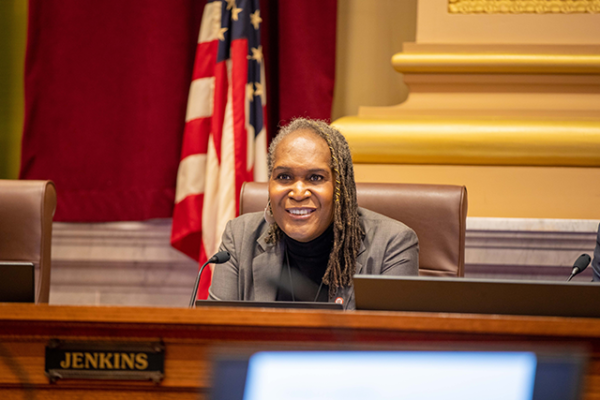Minneapolis Ward 8 City Council Candidate’s Stances on Transit, Biking, Walking, and Rolling
Pictured: Andrea Jenkins
Move Minnesota and Our Streets Minneapolis have teamed up on a questionnaire for 2021 Minneapolis city council candidates to learn about their ideas and vision for the future of transportation in Minneapolis.
Access to quality transit, biking, walking, and rolling play an essential role in tackling climate change and ensuring equitable access to the opportunities and services the people of Minneapolis need to live healthy and fulfilling lives.
This questionnaire is for candidate and voter information only. Participating organizations will not be making endorsements in any Minneapolis city elections in 2021. This questionnaire was sent to all candidates, but those not listed have chosen not to respond.
All candidate responses are listed in alphabetical order last name basis.
The Responses
Question 1
What is your primary mode of transportation? How often do you ride transit?
Andrea Jenkins:
Did not respond
Question 2
Rethinking I-94 & Environmental Justice: Climate change and pollution disproportionately affect Black, Indigenous, and People of Color. Children in North Minneapolis—particularly those closest to I-94 in the 55411 & 55412 zip codes are hospitalized at rates as high as 4x compared to children in other parts of Minneapolis. During the last Minneapolis freeway reconstruction project, the city withdrew municipal consent for the I-35W reconstruction until the Minnesota Department of Transportation and the Metropolitan Council redesigned I-35W with highway Bus Rapid Transit, resulting in the Orange Line I-35W. Currently, the Minnesota Department of Transportation is exploring reconstruction efforts for I-94 going North out of the city; what role, if any, do you see the city playing in rethinking our freeways and addressing environmental injustice and pollution from freeways? Are there specific transportation or transit efforts you would pursue to achieve this?
Andrea Jenkins:
I was involved in the I-35W shift to a transit-centric project. I think the city should play the same role in the proposed reconstruction/expansion project to incorporate transit elements into the design and subsequent reconstruction.
Question 3
Minneapolis Transportation Action Plan: State and city studies show that we will need to reduce how much people drive (“vehicle miles traveled”) to reach established emissions-reduction goals. Transportation is the #1 source of climate change pollution in Minnesota. The Minneapolis Transportation Action Plan has highlighted changing “mode split” (the shifting of car trips to transit, biking, or walking) as a critical strategy in reaching and measuring VMT reduction and in achieving overall emission reduction goals. The city now has an ambitious “mode split goal” to shift 60% of car trips to biking, walking, and transit by 2030. Despite an increase in bike and pedestrian infrastructure investments, data from the previous decade shows that VMT numbers dropped only 2% between 2007-2016. What specific transit, biking, and walking policies and investments should the city make, if any, to achieve Transportation Action Plan mode split goals? What new or accelerated interventions, if any, do you see as appropriate for reaching VMT goals by 2050?
Andrea Jenkins:
I believe that projects like “bus only lanes” to speed up trips and reduce congestion make sense. More investments in pedestrian focused infrastructure in historically POC communities, protected bike lanes also could help reduce VMT. I would like to see more projects like the Midtown Greenway crisscrossing the City that offer fast, safe, and pleasant bicycle transportation with few or no stops per mile and priority at intersections.
Question 4:
Bottineau/Blue Line Extension: This LRT project was deemed unworkable on its currently planned route on BNSF right-of-way. However, there is still substantial interest in a Bottineau project because transportation connects people to social activity, economic opportunity, educational institutions, healthy food, and critical health services. North Minneapolis has been historically underserved by transit compared to other parts of the city; however, there are also community concerns from North Minneapolis residents of displacement and gentrification surrounding the Blue Line extension project and transit-oriented development.
What policies or programs, if any, should the city implement to ensure the success of major transit investments for both current and future communities along the line?
Andrea Jenkins:
We must include community in the decision making processes, and create mechanisms for community ownership along the “Blue Line” corridor to address potential gentrification. The City Council and Met Council should prioritize projects that create affordable housing and workforce housing opportunities for residents.
Question 5:
Hennepin Avenue: The City of Minneapolis is currently considering several design options for the stretch of Hennepin Avenue that runs between Lake Street and Franklin Avenue. The currently proposed design options for Hennepin Avenue include bus lanes, two-way traffic, and loading and parking zones; one option includes bike infrastructure, and the other design includes street greening.
On streets like Hennepin Avenue—which are key commercial corridors, have dense housing nearby, and have limited space to work with—what approach, if any, should the city take in balancing current and long-term needs for our transportation networks?
Andrea Jenkins:
The City should pursue the option that includes a two-way cycle track on one side of the roadway, and improve it by raising the pavement of the bikeway through intersections.
Question 6
Bus Priority: Transit operations cross multiple jurisdictions of government. Metro Transit manages bus operations and service schedules. The city of Minneapolis and Hennepin County have authority over most of the streets Metro Transit Buses run through; and, the city also has control of the stoplights within city limits.
What improvements, if any, should the city be pursuing to improve speed and reliability for Minneapolis transit riders? How do you see the city, Metro Transit, and Hennepin County collaborating to improve bus service?
Andrea Jenkins:
Vehicle-actuated signal priority for buses should be pursued.
Question 7
Parking Policy: The City of Minneapolis recently eliminated parking minimums; however, the city approved both a multi-thousand Allina parking ramp and proposed a parking plan for the Roof Depot site with spots for nearly every employee or visitor to travel by car, which is not in alignment with the city’s mode shift goals as cited in the TAP.
What role do you think the city should play, if any, in reducing parking to meet mode shift goals?
Andrea Jenkins:
Travel Demand Management Plans for new developments that are in keeping with the City’s mode shift goals should be required and parking ramps should be sized consistently with these plans.
Question 8
Traffic Enforcement: A recent article in the Star Tribune found that 78% of police searches that started as stops for moving or equipment violations from June 2019 through May 2020 were of Black or East African drivers. Also, in 2016, Our Streets Minneapolis published a report that suggests black bicyclists face greater threats of police violence than white bicyclists, especially for small infractions like failure to use a light or riding on the sidewalk.
What role should the city play, if any, in changing or maintaining how minor traffic violations are enforced? or maintaining how minor traffic violations are enforced?
Andrea Jenkins:
The City should require the MPD to set goals to eliminate these per capita disparities for Black motorists and cyclists, and be held accountable if the goals are not met. We must stop low level traffic stops similar to St. Paul’s initiative.
Question 9
Snow Removal: Sidewalks that are inadequately shoveled create both risks and barriers for pedestrians and transit riders. We also know that the risks and barriers aren’t experienced equally– with Minneapolis senior citizens and community members with disabilities being the most impacted by neglected sidewalks in the wintertime.
What changes, if any, would you advocate for in how our city addresses snow and ice removal from sidewalks during winter?
Andrea Jenkins:
City assistance should be available to assist with snow removal for those who have legitimate barriers to doing so on the properties for which they are responsible, and there should be a rapid response system to correct violations related to snow removal in areas key for foot-travel. This can be an employment program for young people of color.
Question 10
Bike, Walk, Roll: What actions, if any, will you take to make Minneapolis better for biking, walking, and rolling by the end of your term, if you are elected?
Andrea Jenkins:
The Pedestrian Priority and Low-Stress Networks identified in the City’s Transportation Action Plan should be funded for implementation.
Thank you to the candidates for their responses to the questionnaire.
Early voting is already underway in Minnesota. For more information on how to check your voter registration, absentee voting, and early voting please visit the Minnesota Secretary of State’s website.
Be a Voter
Election Day is coming up! If you want your elected officials to reflect your values, pledge to vote on or before November 2.

